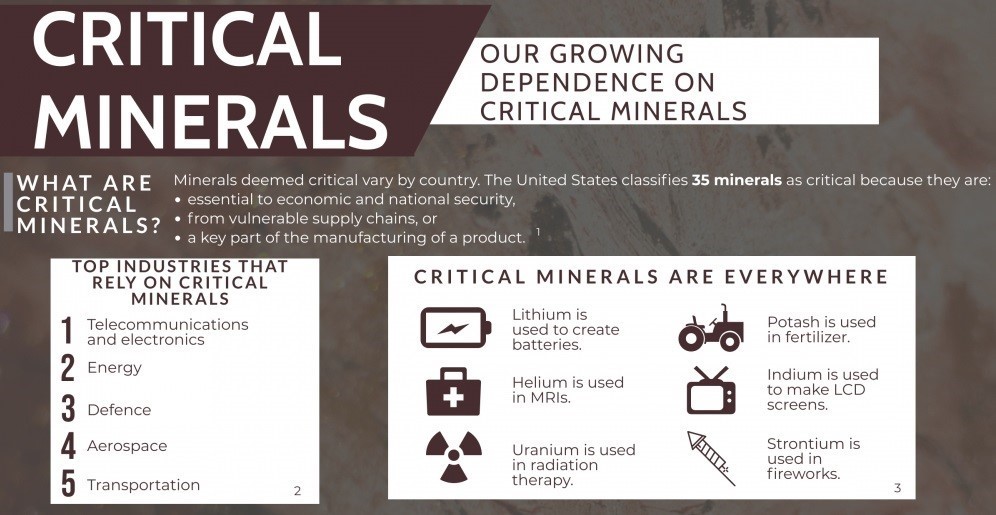International Relations
India - Australia Critical Minerals Investment Partnership
- 16 Mar 2023
- 7 min read
For Prelims: Critical Minerals, QUAD, Indo-Pacific Region
For Mains: India and Australia Relations, India-Australia Critical Minerals Investment Partnership, Significance.
Why in News?
Recently, India and Australia have reached a significant milestone in working towards investment in critical minerals projects to develop supply chains between the two countries.
What are Critical Minerals?
- About: Critical minerals are elements that are the building blocks of essential modern-day technologies and are at risk of supply chain disruptions.
- Examples: Copper, lithium, nickel, cobalt, and rare earth elements are critical components in many of today's rapidly expanding clean energy technologies, ranging from wind turbines and power grids to electric vehicles. As the transition to clean energy accelerates, demand for these minerals will skyrocket.
- Indian Policy: India’s Department of Science and Technology, in collaboration with the Council on Energy, Environment and Water, drafted the Critical Minerals Strategy for India in 2016, with a focus on India’s resource requirements till 2030.
- The Indian Critical Minerals Strategy has identified 49 minerals that will be vital for India’s future economic growth.
What are the Key Highlights of the Critical Minerals Investment Partnership (CMIP)?
- Two lithium and three cobalt projects are among the five target projects that CMIP has chosen for thorough due diligence.
- Australia produces almost half of the world’s lithium and is the second-largest producer of cobalt and the fourth-largest producer of rare earths.
- The Partnership's investments will aim to create new supply chains supported by essential minerals processed in Australia, which will support India's efforts to reduce emissions from its energy network and establish itself as a hub of manufacturing, including for electric vehicles.
- Together, the two countries are dedicated to reducing emissions, ensuring energy security, and expanding the global markets for essential minerals and clean technology.
How have the India-Australia Trade Relations been so far?
- Cordial Relations: India and Australia have excellent bilateral relations that have undergone transformational evolution in recent years, developing into a friendly partnership on a positive track.
- This is a unique partnership defined by shared values such as parliamentary democracies, Commonwealth traditions, increased economic engagement, long-standing people-to-people ties, and increased high-level interaction.
- India-Australia Comprehensive Strategic Partnership: It was launched during the India-Australia Leaders' Virtual Summit in June 2020, and it is the foundation of India and Australia's bilateral relations.
- Trading Partners: India-Australia bilateral trade in both goods and services is expected to reach USD 27.5 billion in 2021 consisting largely of raw materials, minerals and intermediate goods.
- Others: India and Australia are partners in the trilateral Supply Chain Resilience Initiative (SCRI) arrangement along with Japan which seeks to enhance the resilience of supply chains in the Indo-Pacific Region.
- Further, India and Australia are also members of the QUAD grouping (India, the US, Australia, and Japan), to enhance cooperation and develop partnerships across several issues of common concern.
What are Countries Around the World doing About Critical Minerals Supply?
- United States: In 2021, the US ordered a review of vulnerabilities in its critical minerals supply chains and found that an over-reliance on foreign sources and adversarial nations for critical minerals and materials posed national and economic security threats.
- India: It has set up KABIL or the Khanij Bidesh India Limited, a joint venture of three public sector companies, to ensure a consistent supply of critical and strategic minerals to the Indian domestic market.
- It ensures the mineral security of the nation; it also helps in realizing the overall objective of import substitution.
- Other Countries: In 2020, the US, Canada, and Australia launched an interactive map of critical mineral deposits intending to help governments to identify options to diversify the sources of their critical minerals. Uk's critical minerals strategy' sets out the government's plans for improving the resilience of critical minerals supply chains and increasing our security of supply. Through this strategy, the UK will: accelerate the growth of UK's domestic capabilities.
Conclusion
- The CMIP between Australia and India represents a significant milestone in bilateral relations.
- The two countries should work together to ensure that the alliance is properly implemented and to investigate opportunities for collaborative research and development. The vital minerals industry may change as a result of the CMIP, which will also help both countries' economies grow and thrive.
UPSC Civil Services Examination, Previous Year Questions (PYQs)
Q.1 Recently, there has been a concern over the short supply of a group of elements called ‘rare earth metals’. Why? (2012)
- China, which is the largest producer of these elements, has imposed some restrictions on their export.
- Other than China, Australia, Canada and Chile, these elements are not found in any country.
- Rare earth metals are essential for the manufacture of various kinds of electronic items and there is a growing demand for these elements.
Which of the statements given above is/are correct?
(a) 1 only
(b) 2 and 3 only
(c) 1 and 3 only
(d) 1, 2 and 3
Ans: (c)





